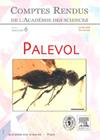布里甘阶岩石中的有孔虫和钙质藻类对摩洛哥vis - serpukhovian边界段recognition的指示作用
IF 1.3
4区 地球科学
Q3 PALEONTOLOGY
引用次数: 0
摘要
对东梅塞塔Jerada向斜、中梅塞塔azro - khenifra盆地和西梅塞塔Oued Cherrat著名晚vissamim组有孔虫、藻类和问题藻类的修正表明,对这一时期的年代地层单位的认识缺乏西欧有孔虫生物分带中的大多数有孔虫标志。在摩洛哥梅塞塔记录的许多分类群被认为是西欧晚期的亚洲向导,但在梅塞塔,它们最早是在布里格提亚早期记录的。虽然一些有孔虫类群被认为是摩洛哥布里甘梯早期的向导,但这一亚阶段更容易被藻类和问题藻类组合所识别。相比之下,Brigantian晚期,相当于Serpukhovian的下半部,被西欧也记录的典型有孔虫所识别。此外,在这个水平上,藻类没有表现出任何显著的变化。摩洛哥布里甘梯统记录的不寻常和不具代表性的有孔虫组合表明,文献中大多数属于亚洲晚期的露头和剖面应该进行修订,因为正如本研究中少数案例所证明的那样,这些露头可能属于更年轻的布里甘梯统年代地层单位。本文章由计算机程序翻译,如有差异,请以英文原文为准。
Foraminifers and calcareous algae in Brigantian rocks as guides for the recognition of the Viséan-Serpukhovian boundary interval of Morocco
Revision of foraminifers, algae and problematic algae of well-known late Viséan formations in the Jerada syncline in the Eastern Meseta, Azrou-Khenifra Basin in the Central Meseta and Oued Cherrat in the Western Meseta, suggests that the recognition of the chronostratigraphic units within this period lacks most of the foraminiferal markers in the Western European foraminiferal biozonations. Many taxa recorded in the Moroccan Meseta are considered as late Asbian guides in Western Europe, but in the Meseta, they are first recorded in the early Brigantian. Although some foraminiferal taxa are proposed as guides for the early Brigantian in Morocco, this substage is far more easily recognized by the algal and problematic algal assemblages. In contrast, the late Brigantian, and thus, the equivalent to the lower part of the Serpukhovian, is recognized by typical foraminifers that have been also recorded in Western Europe. Moreover, the algae do not display any significant change at this level. The unusual and unrepresentative foraminiferal assemblages recorded from the Brigantian in Morocco, suggest that most of the numerous outcrops and sections ascribed to the late Asbian in the literature should be revised because, as is demonstrated in a few cases in this study, those outcrops probably belong to younger Brigantian chronostratigraphic units.
求助全文
通过发布文献求助,成功后即可免费获取论文全文。
去求助
来源期刊

Comptes Rendus Palevol
地学-古生物学
CiteScore
2.10
自引率
0.00%
发文量
39
审稿时长
17.6 weeks
期刊介绍:
Comptes Rendus Palevol is a fully electronic and peer-reviewed journal, with a continuous publication stream, devoted to palaeontology, prehistory and evolutionary sciences. It publishes original research results, in French or English, in the following domains: systematic and human palaeontology, prehistory, evolutionary biology and macroevolution, and history of sciences. Thematic issues may also be published under the responsibility of a guest editor. All articles published in Comptes Rendus Palevol are compliant with the different nomenclatural codes. A copyright assignment will be signed by the authors before publication.
 求助内容:
求助内容: 应助结果提醒方式:
应助结果提醒方式:


